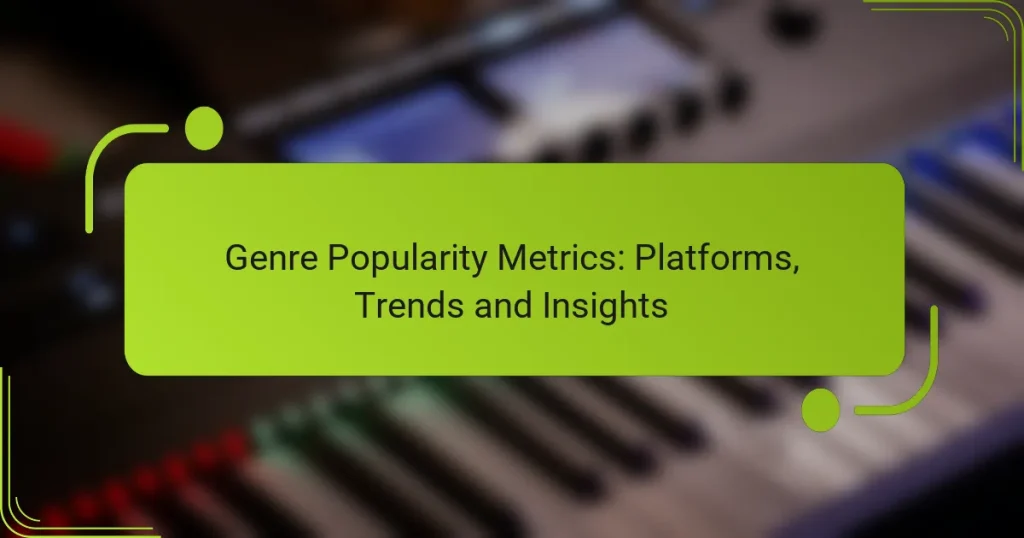Understanding genre popularity metrics is essential for creators and marketers across various media platforms, including music, gaming, literature, film, and podcasts. By leveraging insights into audience preferences and emerging trends, stakeholders can make informed decisions that enhance engagement and drive revenue. Recent shifts towards niche and diverse genres highlight the evolving landscape of consumer interests, emphasizing the importance of adapting to these changes.

Which platforms track genre popularity metrics?
Several platforms specialize in tracking genre popularity metrics across various media, including music, gaming, literature, film, and podcasts. These platforms provide valuable insights into trends, audience preferences, and emerging genres, helping creators and marketers make informed decisions.
Spotify for music trends
Spotify tracks music trends through its extensive streaming data, showcasing the popularity of different genres and artists. The platform offers features like Spotify Wrapped, which summarizes user listening habits and highlights trending genres over the year.
Users can explore genre-specific playlists and charts, making it easy to identify rising trends. Additionally, Spotify’s algorithm suggests music based on listening patterns, further reflecting genre popularity.
Steam for gaming statistics
Steam provides comprehensive gaming statistics, including genre popularity metrics based on user engagement and sales data. The platform displays real-time player counts and trends for various game genres, allowing developers to gauge interest and competition.
Steam’s “Top Sellers” and “Most Played” lists categorize games by genre, helping users discover popular titles. Developers can use this data to tailor their marketing strategies and game development efforts effectively.
Goodreads for book genres
Goodreads tracks book genres through user ratings, reviews, and reading lists, offering insights into what genres are currently popular among readers. The platform allows users to explore genre-specific lists and recommendations based on community engagement.
Authors can leverage Goodreads’ genre data to understand reader preferences and market their books accordingly. Participating in genre-specific groups can also enhance visibility and engagement with target audiences.
Netflix for film and series popularity
Netflix monitors film and series popularity through viewer data, including watch times and user ratings. The platform’s algorithms recommend content based on genre preferences, helping users discover trending films and series.
Netflix often releases lists of popular titles by genre, reflecting current viewer interests. This data can guide filmmakers and producers in understanding market demands and audience tastes.
Apple Podcasts for podcast metrics
Apple Podcasts tracks podcast popularity through metrics such as downloads, subscriptions, and listener ratings. The platform categorizes podcasts by genre, allowing users to easily find trending content in their preferred categories.
Podcasters can use this data to identify successful genres and tailor their content to meet audience demands. Engaging with listeners through feedback and reviews can also enhance visibility and growth in specific genres.

How do genre popularity metrics influence digital products?
Genre popularity metrics play a crucial role in shaping digital products by guiding development, marketing, and user experience strategies. By analyzing these metrics, companies can better align their offerings with audience preferences, ultimately driving engagement and revenue.
Targeted marketing strategies
Understanding genre popularity allows businesses to tailor their marketing efforts effectively. For instance, if a particular genre is trending, companies can create targeted campaigns to reach audiences who are most likely to engage with that content. This can involve utilizing social media platforms, email marketing, or influencer partnerships to amplify reach.
Additionally, segmenting audiences based on genre preferences can enhance the effectiveness of promotional efforts. Brands should consider using data analytics tools to identify which genres resonate with specific demographics, allowing for more personalized marketing approaches.
Content creation decisions
Genre popularity metrics directly inform content creation by highlighting what themes and styles are currently in demand. Creators can analyze trends to decide which genres to focus on, ensuring that their work aligns with audience interests. For example, if horror is experiencing a surge in popularity, producers might prioritize developing more content in that genre.
Moreover, leveraging genre data can help in resource allocation, such as budgeting for production or selecting talent that fits the genre’s appeal. This strategic approach can lead to higher-quality content that meets market expectations.
User engagement optimization
Metrics on genre popularity can significantly enhance user engagement by informing user interface design and content recommendations. Platforms can utilize algorithms to suggest content based on users’ genre preferences, increasing the likelihood of interaction and retention. For example, streaming services often highlight trending genres on their homepages to attract viewers.
Furthermore, understanding genre dynamics can help in crafting community features, such as forums or discussion groups centered around popular genres. This fosters a sense of belonging among users and encourages them to engage more deeply with the platform and its offerings.

What are the current trends in genre popularity?
Current trends in genre popularity indicate a significant shift towards niche and diverse genres across various platforms. This evolution reflects changing consumer preferences, driven by accessibility and the desire for unique experiences.
Rise of indie music genres
Indie music genres are experiencing a notable rise in popularity, fueled by digital platforms that allow independent artists to reach wider audiences. Genres such as lo-fi, bedroom pop, and synthwave are gaining traction, appealing to listeners seeking authenticity and innovation.
Streaming services like Spotify and Bandcamp have become essential for indie musicians, enabling them to distribute their music without traditional label constraints. This democratization of music production has led to a flourishing of unique sounds that resonate with diverse audiences.
Growth of immersive gaming experiences
Immersive gaming experiences are transforming the landscape of entertainment, with genres like virtual reality (VR) and augmented reality (AR) gaining substantial popularity. These genres offer players engaging environments that enhance storytelling and interactivity.
Platforms such as Oculus and PlayStation VR are at the forefront, providing gamers with innovative experiences that blend gameplay with real-world elements. As technology advances, the demand for immersive experiences is expected to grow, attracting a wider audience and fostering new gaming genres.
Popularity of diverse literature
The popularity of diverse literature is on the rise, reflecting a broader cultural shift towards inclusivity and representation. Readers are increasingly seeking out works that explore different perspectives, cultures, and experiences, leading to a surge in genres like multicultural fiction and [censured] literature.
Book retailers and platforms like Goodreads are promoting diverse authors and stories, making it easier for readers to discover new voices. This trend not only enriches the literary landscape but also encourages discussions around social issues, making literature a powerful tool for change.

What criteria should be considered for selecting genre metrics?
When selecting genre metrics, it is essential to focus on criteria that align with your goals and the specific characteristics of your target audience. Key factors include relevance, data accuracy, and the ability to derive actionable insights from the metrics.
Relevance to target audience
Relevance is crucial when choosing genre metrics, as it ensures that the data reflects the interests and preferences of your audience. Consider metrics that directly relate to the genres your audience engages with, such as streaming counts, social media mentions, or user ratings.
For example, if your target audience is primarily interested in indie music, metrics like the number of playlists featuring indie tracks or engagement rates on platforms like Bandcamp can provide valuable insights. Tailoring your metrics to your audience’s preferences can enhance your strategy and improve engagement.
Data accuracy and reliability
Data accuracy and reliability are vital for making informed decisions based on genre metrics. Ensure that the sources of your data are reputable and that the metrics are consistently measured over time. This may involve cross-referencing data from multiple platforms to validate findings.
For instance, using metrics from established platforms like Spotify or Apple Music can provide a more reliable picture of genre popularity compared to less-known sources. Regularly reviewing and updating your data sources will help maintain the integrity of your insights.

What insights can be drawn from genre popularity metrics?
Genre popularity metrics provide valuable insights into consumer preferences and market trends, helping businesses tailor their offerings. By analyzing these metrics, companies can better understand which genres resonate with audiences and adjust their strategies accordingly.
Consumer behavior analysis
Analyzing consumer behavior through genre popularity metrics reveals how audiences engage with different types of content. For instance, streaming platforms often track viewing habits to identify which genres attract more viewers during specific times of the year, such as horror films around Halloween or romantic comedies during Valentine’s Day.
Understanding these patterns allows businesses to optimize their marketing efforts and content recommendations. For example, if data shows a surge in interest for a particular genre, companies can promote related titles more aggressively, potentially increasing viewer engagement and subscription rates.
Market gap identification
Genre popularity metrics can help identify gaps in the market where consumer demand is not being met. By examining trends, businesses can spot genres that are underrepresented in their offerings, such as niche categories like indie films or foreign-language content.
To capitalize on these gaps, companies should consider conducting surveys or focus groups to gather direct feedback from potential viewers. This approach can guide content development and acquisition strategies, ensuring that new releases align with audience interests and fill existing voids in the market.

How does genre popularity vary by region?
Genre popularity can significantly differ by region due to cultural preferences, local trends, and market availability. Understanding these variations helps content creators and marketers tailor their strategies to specific audiences.
Key Factors Influencing Genre Popularity
Several factors influence genre popularity across different regions, including cultural heritage, media consumption habits, and local events. For instance, regions with a strong tradition in music may favor genres like folk or classical, while urban areas might lean towards pop or hip-hop. Additionally, social media trends can rapidly shift preferences, making it essential to stay updated on local influences.
Regional Examples of Genre Popularity
In North America, hip-hop and pop dominate the charts, reflecting a blend of cultural influences and media exposure. Conversely, in Eastern Europe, genres like electronic and folk music are gaining traction, driven by local festivals and a resurgence of traditional sounds. In Asia, K-pop has exploded in popularity, showcasing how regional tastes can evolve rapidly through global connectivity.
Measuring Genre Popularity
To measure genre popularity, platforms often analyze streaming data, social media interactions, and sales figures. For example, services like Spotify and Apple Music provide insights into the most streamed genres in specific regions. Marketers can leverage these metrics to identify emerging trends and adjust their content strategies accordingly.
Strategies for Adapting to Regional Preferences
When targeting specific regions, it’s crucial to adapt content to align with local tastes. This may involve collaborating with local artists, incorporating regional themes, or using language that resonates with the audience. Avoid generic approaches; instead, focus on authenticity to build a genuine connection with the audience.


